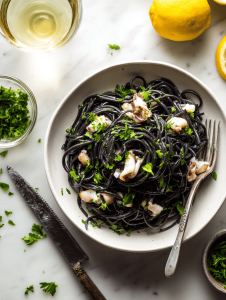Squid ink pasta feels like a secret handshake among cooks. Its rich, umami depth is a reminder of seaside markets and late-night kitchens. I love how it turns a simple dinner into an experience—dark, dramatic, and full of oceanic whispers. It’s a dish that invites attention, patience, and a little daring.
Why This Dish Calls Me Back Again and Again
It’s the complexity—how the ink amplifies the seafood’s briny sweetness. Plus, the way it turns a humble pasta into an artful plate. I love the ritual of cooking it, watching the color deepen, smelling the ocean in my kitchen. It’s a dish that feels like a small rebellion, a splash of the wild sea on your plate.
Inside the Ingredients: What Makes This Dish Sing
- Squid ink: Gives the pasta its bold, briny color and depth—think smoky ocean air. Swap for a splash of extra-virgin olive oil if you prefer a milder dish.
- Black pasta (or regular pasta + squid ink dye): The canvas for the ink—al dente is key, so don’t overcook. Use regular pasta if you can’t find the ink version.
- Fresh squid rings: Tender and mild, they add a fresh seafood bite. Frozen squid works fine, just thaw and pat dry first.
- Garlic: Fills the kitchen with a warm, pungent aroma—don’t skip it. For a milder profile, use half clove.
- White wine: Adds brightness and acidity—use a dry one, no need to splurge.
- Lemon juice: A splash to cut through the richness—bright and zesty, like a fresh seaside breeze.
- Chili flakes: A pinch adds a gentle heat—adjust to your spice tolerance.
Tools of the Trade for Black Pasta with Squid Ink
- Large Stockpot: Boils the pasta evenly without crowding.
- Slotted Spoon: Lifts pasta out of boiling water gently.
- Non-stick Pan: Sautés garlic and squid without sticking or burning.
- Measuring Cups and Spoons: Accurately measure liquids and seasonings.
- Lemon Squeezer: Extracts maximum juice easily.
Crafting the Perfect Black Pasta with Squid Ink: A Step-by-Step Guide
Step 1: Fill a large pot with water, salt generously, and bring to a rolling boil—think seawater brine.
Step 2: Add the squid ink pasta carefully, stirring immediately to prevent sticking.
Step 3: Cook for 8-10 minutes, until al dente—firm but with a slight chew, a little echo of the sea.
Step 4: Meanwhile, heat a splash of olive oil in a pan over medium heat, about 160°C (320°F).
Step 5: Add finely chopped garlic, sauté till fragrant, about 30 seconds.
Step 6: Toss in cleaned squid rings, cook for 2-3 minutes until opaque.
Step 7: Deglaze with a splash of white wine, let it reduce for a minute.
Step 8: Drain the pasta, reserving a cup of starchy water.
Step 9: Combine pasta with squid and sauce, adding a splash of reserved water to loosen.
Step 10: Finish with a squeeze of lemon juice, fresh parsley, and a pinch of chili flakes.
Cooking Like a Pro: Key Checkpoints for Black Pasta with Squid Ink
- The pasta should be just tender, not mushy, with a slight bounce.
- The squid rings turn opaque and firm, not rubbery, within 2-3 minutes of cooking.
- The sauce should shimmer with a slight sheen, not appear watery or greasy.
Avoid These Common Pitfalls in Black Pasta with Squid Ink
- Overcooked squid, turning rubbery.? Reduce heat if garlic browns too quickly, to avoid bitterness.
- Pasta sticking together.? Remove from heat immediately and serve to prevent rubberiness.
- Sauce too watery.? Stir often during cooking and add a little olive oil if necessary.
- Lack of color or flavor in the ink.? Simmer longer or add a bit of extra squid ink to intensify flavor.
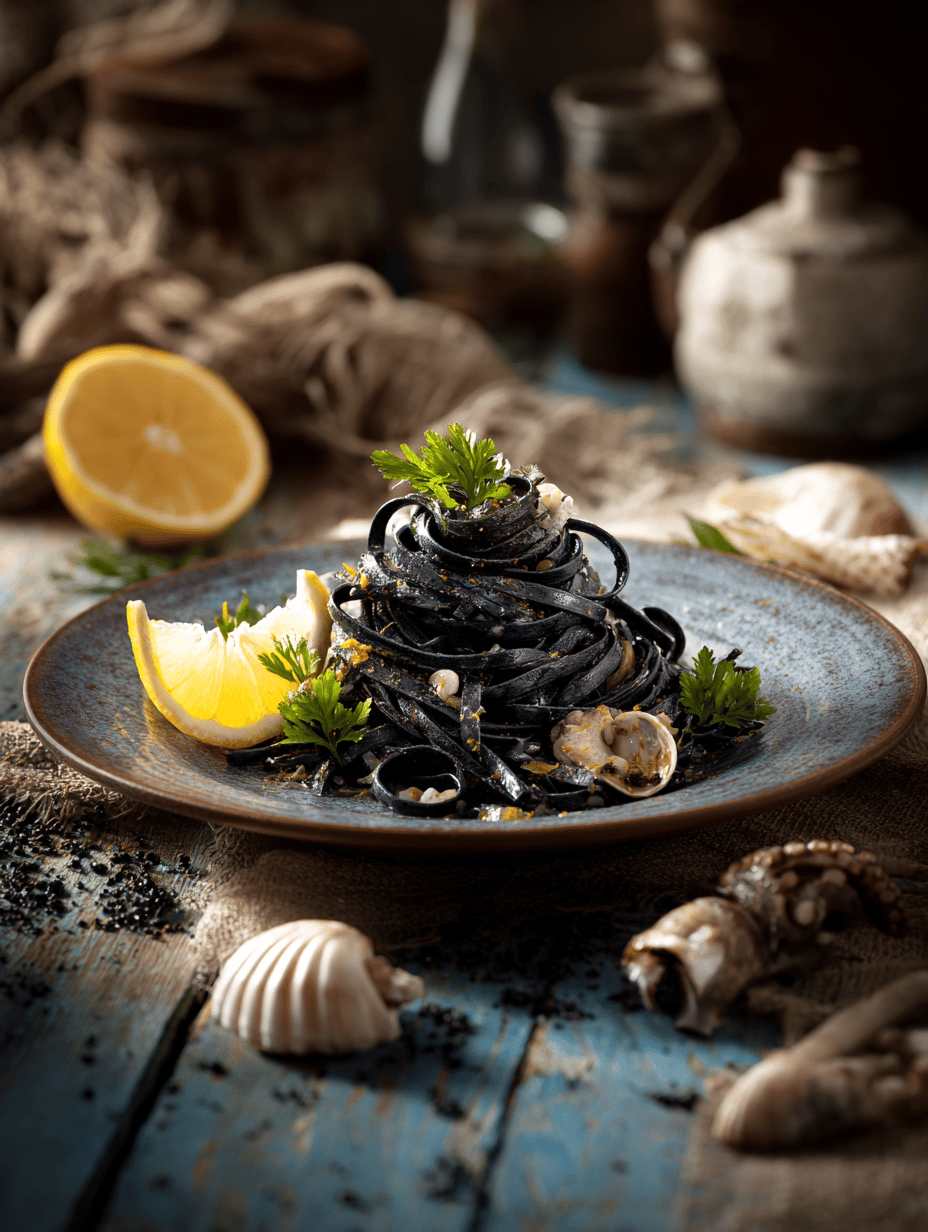
Black Squid Ink Pasta with Fresh Squid
Ingredients
Equipment
Method
- Fill a large stockpot with water, add a generous amount of salt, and bring to a rolling boil.
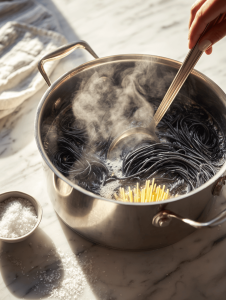
- Add the black pasta carefully to the boiling water, stirring immediately to prevent sticking, and cook until just al dente, about 8-10 minutes.
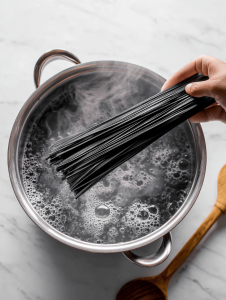
- While the pasta cooks, heat olive oil in a non-stick pan over medium heat until shimmering and fragrant.
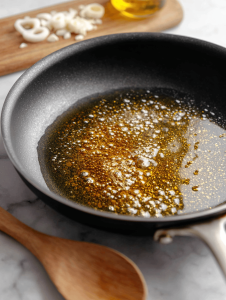
- Add the finely chopped garlic to the pan, sauté for about 30 seconds until fragrant and slightly golden.
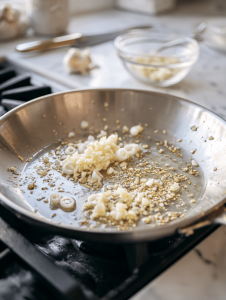
- Toss in the fresh squid rings, cook for 2-3 minutes until they turn opaque and are just tender with a slight bounce.
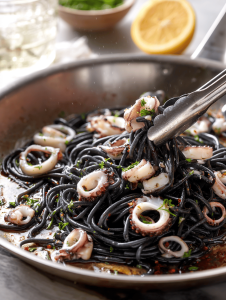
- Pour in the white wine, allowing it to deglaze the pan and reduce slightly for about a minute, releasing a fragrant aroma.
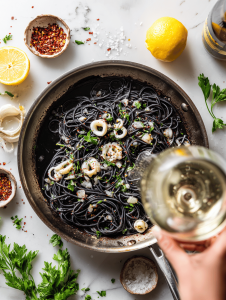
- Drain the pasta, reserving about a cup of starchy water for loosening the sauce later.
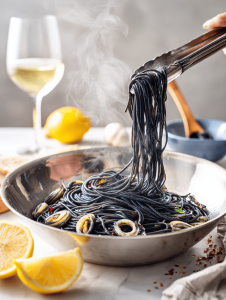
- Add the drained pasta to the pan with squid and wine, tossing well to coat everything evenly.
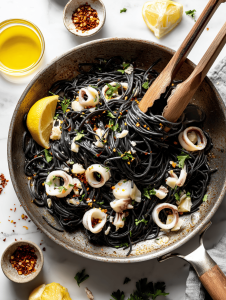
- Squeeze fresh lemon juice over the pasta, adding a pinch of chili flakes for heat, and stir to combine.
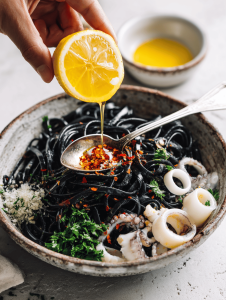
- If the sauce seems thick, add a splash of the reserved starchy water to loosen and create a glossy finish.
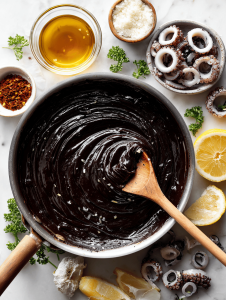
- Garnish with chopped fresh parsley and serve immediately, enjoying the vibrant color and oceanic aroma.
